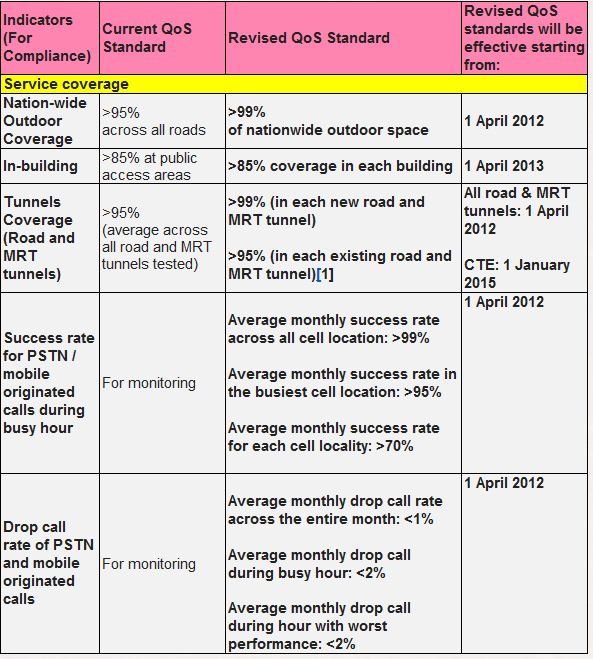Cellphone users in Singapore can expect extended coverage in buildings, on roads and when travelling in an MRT train underground, when stricter rules on 3G coverage unveiled today by the government regulator kick in as soon as April 2012.
Following a number of high-profile network outages last year, the Infocomm Development Authority (IDA) today spelt out the new rules, which will include 85 per cent coverage for each building here. Currently, telcos only have to cover 85 per cent of “public access areas”.
For commuters, the coverage will now include all road and MRT tunnels as well as the CTE by 2015, extending from the previous requirement of 95 per cent across road and MRT tunnels tested. In all, about 99 per cent of the outdoor space on the island is to be blanketed by 3G signals. Previously, the requirement was only 95 per cent across all roads.
And each time any of the three telecom operators here – SingTel, StarHub, M1 – fails to meet one requirement, they can be fined up to S$50,000, instead of the previous “slap on the wrist” S$5,000 per indicator per month.
Immediately, telcos are expected to react by setting up more equipment in the additional areas they have to cover. They might also check their existing 3G coverage by going to popular locations, like shopping malls, to test out the experience.
But it remains to be seen if the tougher rules will solve a bigger problem – the quality of service expected by users, even as more of them start logging on with smartphones and clog up networks with minute-by-minute Facebook updates.
Already, SingTel has proactively listed “typical” broadband speeds on its 3G mobile data plans and promised a “priority” lane for customers who pay more for high-tier plans. But there is still no “guarantee” of what a user can get, because the experience on the go is ultimately still determined by the number of users in an area – think of Suntec City and the hordes of people there during a computer bazaar, for example.
Still, the new rules will mean that telcos would have to prevent a repeat of the outages that M1 and SingTel users suffered last year. They should also push telcos to fix another problem – this dumping of users back on 2G at places which are expected to offer 3G speeds.
Know a place that consistently doesn’t offer 3G data? Share in the comments!







I have a unit at blk 269 queen street at level 1,it just right behind the new “Bugis plus” shopping mall.i barely have 3G network in it and though sometimes I can still receive calls but when I pick up,the other party that is calling totally can’t hear
My Voice.some say that it is because of all my walls are made out of partitions.but I don’t think that partition will cut off your coverage.and only my
Unit have this big problem.i don’t wish to subscribe a business boradband as
I only wanna use it leisure and most important that I must be able to use the phone to call!
If IDA/M1 cannot help,can anyone tells me how to settle this problem as when I step out of my
Door,I’m able to use my
Phone with atleast 3bars..
I come to Singapore on a frequent basis for work and I’d have to say that 3G here would have to be one of the worst, loading web pages is so slow especially late afternoon and evening, for a so called modern first world country its not good enough.
The real solution here is not so much to extend coverage of 3G signals, but really, to extend coverage of Wireless@SG signals so that it covers as much of Singapore as possible.
Why Wireless@SG?
Because no matter how you extend 3G signals, it will never be able to beat the blazing speed of Wi-Fi. Even though Wireless@SG speeds may be slower than home broadband, it is still MUCH faster than 3G, no matter what…
If you look at how telcos in Singapore are gearing up to put a cap on unlimited data plans in future, it is very clear that Wi-Fi is going to be the way to go forward in future, especially in terms of costs to the consumer.
The cost of living in Singapore is getting higher and higher.
Increasingly, more and more Singaporeans are trying to cut down on paying to surf the Internet on-the-go, because the costs really do add up at the end of the month. This may not be true now because of generous unlimited-data plans, but unlimited-data plans will be a thing of the past in the future, mark my words.
So, this I say to IDA: let the telcos play catch-up with 3G(or 4G for that matter – neither impresses me anyway…) but on its side, IDA really needs to ramp up the upgrade and roll-out of the Wireless@SG network to even more parts of Singapore, so that the Wireless@SG network is more pervasive and extensive in Singaporeans’ lives, with more hotspots all over the country. This will not only dramatically help to push up national workforce productivity across the board, but it will also help to put a damper on the escalating cost of living for all Singaporeans, and help to level the playing ground for those in the lower-income group in Singapore.
No. There’s one thing you forgot to take into account: battery life. Same reason why 4G/LTE isn’t even feasible at the moment, what use is a dead phone within 5 hours? So until battery technology catches up, it still makes sense to increase bandwidth on existing 3G infrastructure.
SingTel needs to increase the bandwidth at places, not the coverage! I can barely download data at Suntec with full signal…
Are these one of those “for show” rules, or will IDA really enforce them?
Higher floors of The Sail @ Marina Bay face dropped calls & poor 3G network on Singtel
Woodlands circle reception are very bad. Only 1 bar for 3g IF got it. Most of the times only 3bar with no 3g.
It appears that the exact QoS is not defined, or at least not in public. The word “coverage” is just a general description. For example on the green camp, one can get “full signal” bars and 3G icon on the phone. But one will not be able to view any web pages or download anything. So telcos can claim that they have “coverage” even though they too congested to serve any packet traffic.
It’s the exact same thing for the Red camp, full signal most of the time but NO data is being transferred. It seems like it’s a capacity issue, NOT coverage.
I think the regulatory board needs to look more in-depth and fix the real problem.